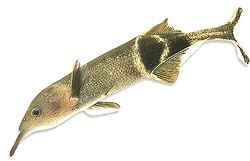Mormyrinae
| Mormyrinae | |
|---|---|
 |
|
| The Peters' elephantnose fish, Gnathonemus petersii, has the largest brain-to-body weight ratio of all known vertebrates. | |
| Scientific classification | |
| Kingdom: | Animalia |
| Phylum: | Chordata |
| Class: | Actinopterygii |
| Order: | Osteoglossiformes |
| Family: | Mormyridae |
| Subfamily: | Mormyrinae |
| Genera | |
|
see text |
|
see text
The subfamily Mormyrinae contains all but one of the genera of the African freshwater fish family Mormyridae in the order Osteoglossiformes. They live in muddy water. They are often called elephantfish due to a long protrusion below their mouths used to detect buried invertebrates that is suggestive of a tusk or trunk (some such as Marcusenius senegalensis gracilis are sometimes called Trunkfish though this term is usually associated with an unrelated group of fish). They can also be called tapirfish.
Fish in this subfamily have a high brain to body mass ratio due to an expanded cerebellum (called a gigantocerebellum) used in their electroperception. Linked to this they are notable for holding the zoological record at around 60% as the brains that consume the most energy as a percentage of the body's metabolic rate of any animal. Previous to this discovery, it was the “human brain, which had been thought to hold the record in this respect”.p. 605 The human brain in comparison uses only 20%.
Mormyrinae is the largest subfamily in the Osteoglossiformes order with around 170 species.
The range with which the adult brain in all animals regardless of body size consumes energy as a percentage of the body's energy is roughly 2% to 8%. The only exceptions of animal brains using more than 10% (in terms of O2 intake) are a few primates (11–13%) and humans. However, research published in 1996 in the Journal of Experimental Biology by Göran Nilsson at Uppsala University found that mormyrinae brains utilize roughly 60% of their body O2 consumption. This is due to the combination of large brain size (3.1% of body mass compared to 2% in humans) and them being ectothermic.
The body energy expenditure of ectothermic animals is about 1/13 of that of endotherms but the energy expenditure of the brains of both ectothermic and endothermic animals are similar. Other high brain percentage (2.6–3.7 % of the body mass) animals exist such as bats, swallows, crows and sparrows but these due to their endothermy also have high body energy metabolism. The unusual high brain energy consumption percentage of mormyrinae fish is thus due to them having the unusual combination of a large brain in a low energy consuming body. The actual energy consumption per unit mass of its brain is not in fact particularly high and indeed lower (2.02 mg g1 h1) than that in some other fish such as Salmonidae (2.20 mg g−1 h−1). In comparison, that of rats is 6.02 mg g−1 h−1 and humans 2.61 mg g−1 h−1.Table 1
...
Wikipedia
